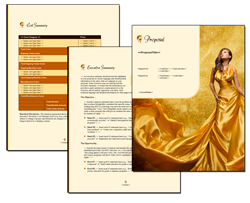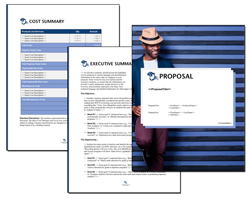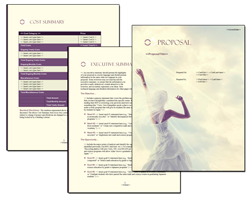
How to Write a Fashion Proposal: Important Steps for Designers
Want to create a fashion proposal that grabs attention and wins contracts? This guide shows you how to write a fashion proposal, covering all essentials from structuring your document to presenting your design portfolio. Whether you're targeting clients, investors, or partners, you'll learn the key topics needed to create a successful and professional proposal.
Key Takeaways
- A well-written fashion proposal is important for attracting investors and clients, showcasing your business vision and commitment to growth.
- Structuring your proposal with key topics like an engaging executive summary, detailed market analysis, and a strong design portfolio enhances credibility and appeal.
- Implementing a comprehensive marketing strategy and providing clear financial projections are critical for demonstrating your brand's potential and attracting support.
Understanding the Importance of a Fashion Proposal

A well-written fashion proposal can set you apart from the competition and help secure contracts. In the fashion world, where trends change and consumer preferences are fickle, a solid business proposal communicates your vision, clarifies your business goals, and helps sell your company to clients, investors, and partners. This is not just about showcasing your creativity; it's about presenting a detailed fashion business plan that demonstrates your commitment and professionalism, which can significantly enhance the trust of potential investors.
In the fashion industry's competitive landscape, a detailed proposal is key to raising funds and scaling your business. Investors and clients want to see that you have a clear plan for your fashion brand's future growth and profitability. A well-structured business plan acts as a testament to your dedication and foresight, making your fashion business stand out in a crowded marketplace and showcasing the benefits of using business planning software to create effective and investor-ready business plans.
Using a fashion proposal template can also be incredibly beneficial in saving time. Templates ensure that your proposal is organized, comprehensive, and visually appealing, impressing clients and stakeholders right from the start. By creating your fashion proposal, you lay the groundwork for a successful fashion design business, paving the way for your fashion empire to thrive in the fashion world.
Understanding the Fashion Industry
The fashion industry is a dynamic and ever-changing market that requires a deep understanding of current trends, consumer behavior, and market analysis. To succeed in this industry, it's important to stay up-to-date with the latest fashion trends, identify your niche, and develop a comprehensive business plan. The fashion industry is not just about creativity; it's about understanding the market and positioning your brand to meet consumer demands. A well-rounded business plan that includes a thorough market analysis can help you navigate this competitive landscape and set your fashion business up for success.
Learn about Current Trends and Market Analysis
Staying abreast of current trends is crucial in the fashion industry. Trends such as sustainable fashion, digital printing, and the influence of social media are shaping the market. For instance, the rise of sustainable fashion reflects a growing consumer preference for eco-friendly products. Digital printing allows for more intricate designs and faster production times, while social media influencers play a significant role in brand promotion and consumer engagement.
Market analysis reveals that the fashion industry is expected to grow annually, with the online fashion market projected to reach hundreds of billions of dollars in the coming year. Understanding your target market is essential; for many fashion businesses, this includes young adults aged 18-35 who are fashion-conscious and active on social media. By conducting a thorough market analysis, you can identify opportunities and tailor your business strategies to meet the needs of your target audience.
Identify Your Niche in the Fashion Industry
Identifying your niche is crucial for standing out in the crowded fashion industry. Your niche could be based on a specific style, target audience, trend, or product line. For example, you might specialize in sustainable fashion, plus-size clothing, or streetwear. By focusing on a niche, you can develop a targeted marketing strategy that resonates with a specific group of consumers.
Understanding your niche allows you to create products that meet the unique needs of your target audience, fostering brand loyalty and differentiation from competitors. A well-defined niche helps streamline your marketing efforts and ensures that your brand message is clear and compelling. This focus can significantly enhance your brand's visibility and appeal in the competitive fashion world.
Structuring Your Fashion Proposal

A fashion proposal outlines your brand's current status and future growth strategies, is important for securing clients, investors, and partnerships, and should be part of comprehensive business plans. A fashion business plan serves as a blueprint for success, ensuring every topic of your business is well-planned. What chapters you include in your proposal are dictated by the intent of the proposal. A product sales proposal, investor pitch proposal, or business plan funding proposal will all be structured differently. Every variation of a proposal can be created using the Proposal Kit.
The business overview section of your fashion proposal should be engaging, precise, and to the point. Foundational topics should include the business name, location, history, and future goals. A well-written company description should tell the story of your fashion brand, highlighting its history, structure, culture, and milestones.
Key components of a fashion business plan include an executive summary, detailed company vision, and market analysis. A fashion design business plan template can guide you through creating a comprehensive and professional proposal.
Creating a Compelling Executive Summary
The executive summary is the heart of your fashion business plan, providing a concise overview of your business, including its name, operations, products, and target market. Its purpose is to give readers a snapshot of your business's mission, unique selling points, and growth strategy. When writing your executive summary, include key topics such as the business name, area of operation, types of clothing, and target market, ensuring it aligns with the overall business plans.
Your USP differentiates your clothing from others in the industry, making it an important component. An effective executive summary should be clear, concise, easy to understand, and free of jargon. It should capture the essence of your business in a snappy and engaging manner.
Remember, the executive summary should be written after the entire business proposal is created, ensuring it accurately reflects the content.
Showcasing Your Design Portfolio

Your design portfolio visually represents your brand's identity and vision. A simple but classy template that aligns with your brand can introduce your fashion brand. Social media templates can also be used to present your unique designs and engage with potential clients.
Detail your product line with sketches, materials, price points, and future collections. This showcases your creativity and design skills while giving clients and investors a clear understanding of your offerings.
A well-presented design portfolio is an important topic of a successful fashion design business, helping to establish your brand as a fashion designer in the competitive fashion world and appealing to potential fashion designers in the fashion industry.
Conducting Thorough Market Analysis
Identifying your target market is important as it helps investors understand potential returns on investment. Understanding your target market involves knowing their preferences, shopping habits, and style to align your fashion line with their needs. When defining your fashion niche, consider your target audience and what makes your brand unique.
Thorough market analysis involves examining trends, competitors, and audience buying habits to understand your target market comprehensively. This analysis should explain how your clothing line meets the wants, needs, and tastes of your targeted market.
Gather firsthand data with primary research methods like surveys, field studies, and focus groups. Enhance your insights with secondary sources such as industry reports, market statistics, and competitor analysis, including direct and indirect competitors. Combined primary and secondary research deepens market insights, guiding decisions and enhancing brand positioning.
A comprehensive business plan can position a fashion brand as knowledgeable and credible in its market, and thorough market analysis is an important part of effective business plans. E-commerce fashion sales are projected to approach tens of billions of dollars in the coming year, highlighting the importance of online visibility and market access. Include important data such as financial records, market insights, and legal documents in the appendix to bolster the main business plan.
Defining Your Products and Services

Clearly and compellingly define your products and services in your fashion business plan. High-quality images representing your best work are important for a design portfolio. Incorporating client testimonials can enhance the credibility of your design portfolio, providing potential clients and investors with real-world examples of your success.
Understanding materials and the manufacturing process ensures the uniqueness and quality of your garments. This knowledge allows you to communicate your brand's commitment to quality and innovation, which can be a significant selling point for new customers and investors alike.
Outlining Your Marketing Strategy
A well-defined marketing strategy is key to raising brand awareness, attracting new customers, and engaging existing ones. Social media is used in building brand awareness, with the majority of marketers using it for this purpose. Instagram, recognized as the top platform for discovering fashion products, is important for brand strategies.
Effective hashtag use on platforms like TikTok and Instagram can increase your branded content's visibility to non-followers. Collaborations with influencers can enhance brand visibility, with approximately half of marketers engaging in such partnerships. Consumer-generated content can significantly enhance purchasing confidence, with the majority of shoppers affirming its positive effect.
To raise brand awareness and engage customers, be prepared to adapt or make changes based on feedback and results. Targeted advertising, such as Facebook's Lookalike Audiences, allows brands to reach potential customers with similar profiles to existing customers. A comprehensive fashion marketing strategy should include advertising, social media, influencers, PR, sales channels, and target audience.
Detailing Your Production Process

Detailing your production process ensures product quality and consistency. Sourcing high-quality materials helps avoid defects and high return rates. Quality assurance starts in the concept and design phase, where quality standards are established.
The production process involves several key steps, including production planning, cutting and sewing, quality control and inspection, and finishing and packaging. A thorough quality check during shipping is vital to ensure garments arrive in excellent condition and on time.
Clear communication of design specifications ensures quality control throughout the manufacturing process.
Operations and Management
Effective operations and management are critical to the success of a fashion business. This includes describing your business operations and management structure, outlining your production process, and establishing a financial plan. A well-organized management structure ensures that all topics of your business run smoothly, from design and production to marketing and sales. Clear operational guidelines and efficient management practices can help you maintain quality, meet deadlines, and achieve your business goals.
Describe Your Business Operations and Management Structure

Your business operations and management structure should include a clear organizational chart that outlines the roles and responsibilities of each team member. Key positions might include a CEO, creative director, marketing manager, and production manager. Each role should be clearly defined to ensure that all team members understand their responsibilities and how they contribute to the overall success of the business.
In addition to the organizational structure, your business operations should include a detailed production process. This process should outline the steps involved in designing, producing, and distributing your products. From sourcing materials to quality control and shipping, each step should be planned to ensure efficiency and consistency. By clearly defining your operations and management structure, you can create a solid foundation for your fashion business, ensuring that all topics of your business are aligned and working towards common goals.
Financial Projections and Budget Planning
A fashion business financial plan should include detailed forecasts of costs, revenues, and cash flows, forming an important part of comprehensive business plans. Financial projections should summarize the business's financial outlook for the first few years, highlighting potential profitability. Revenue, expenses, and profits must be accurately projected in your financial plan.
Financial statements, including budgets and income statements, are critical to demonstrate financial planning in your fashion business. Knowing the break-even point helps determine the sales needed to cover costs and achieve profitability. A comprehensive cash flow statement forecast helps fashion businesses manage their liquidity and identify potential cash shortages.
Forecasting capital expenditures is crucial, as these long-term investments impact cash flow and profitability. The balance sheet provides insight into a business's financial position, detailing its assets, liabilities, and equity. Financial projections in the appendix should cover at least three to five years of operations, ensuring a clear financial outlook for potential investors.
Including Supportive Documents

A well-organized appendix enhances the readability of the business plan, making it easier for stakeholders to locate specific information. The appendix section should include market research, legal documentation, financial statements, and other relevant info to substantiate claims made in the business proposal.
Summarizing the contents of the appendix with a table of contents can greatly enhance navigation and usability. Including additional information or documentation in the appendices provides a comprehensive view of your fashion business.
Using Proposal Kit Templates and Software
The Proposal Kit template and software can be used to write proposals, streamlining the proposal writing process and making it more efficient and organized. Using the Proposal Kit can save time, ensure consistency, and improve the overall quality of your business proposal.
Here are some related samples included in every downloadable Proposal Pack
Here are some related downloadable templates
Summary
Creating a well-structured fashion proposal is important for success in the competitive fashion industry. From understanding the importance of a fashion proposal to detailing your marketing strategy and financial projections, each step is crucial in presenting a case to potential clients and investors. A thorough market analysis, a clear definition of products and services, and a detailed production process further strengthen your proposal.
In conclusion, a fashion proposal not only showcases your creativity and vision but also demonstrates your business acumen and planning. By following these important steps, you can create a proposal that sets your fashion brand apart and paves the way for a successful fashion design business.
 Proposal Kit Professional provides the most content, including legal contracts and a free design theme pack. Plus, advanced software features include custom branding and customizable quoting databases.
Proposal Kit Professional provides the most content, including legal contracts and a free design theme pack. Plus, advanced software features include custom branding and customizable quoting databases. Proposal Pack for Any Business covers this type of proposal and includes samples. There are also some commonly used specialty design themes available:
Proposal Pack for Any Business covers this type of proposal and includes samples. There are also some commonly used specialty design themes available:Photo Design Proposal Packs
Frequently Asked Questions
Why is a fashion proposal important for fashion designers?
A fashion proposal is vital for expressing your vision and establishing trust, helping you secure clients and partnerships. By showcasing your professionalism, you open doors to new opportunities and growth in your design career.
What should be included in the executive summary of a fashion proposal?
To create an impactful executive summary for your fashion proposal, include a brief overview of your business, detailing the name, operations, products, target market, unique selling proposition, and key financial highlights. This summary will captivate your audience and set the tone for your entire proposal!
How can I showcase my design portfolio in a fashion proposal?
To showcase your design portfolio, choose a stylish template that reflects your brand identity and incorporates sketches, materials, price points, and future collections. This will give a comprehensive insight into your fashion offerings and impress your audience!
What is the importance of conducting a thorough market analysis in a fashion proposal?
Conducting a thorough market analysis is crucial as it helps you to understand your target audience, spot trends, and assess competitors. This insight will ensure your fashion line is perfectly aligned with market demands, boosting your decisions and brand success.
How can Proposal Kit templates and software benefit the proposal writing process?
Using Proposal Kit templates and software greatly enhances your proposal writing by ensuring consistency, saving valuable time, and boosting the overall quality of your proposals. Embrace these tools to increase your success.



 Cart
Cart
 Are you just looking for a template, sample, or software for your fashion design proposals? Click these links to skip down the page and get right to it.
Are you just looking for a template, sample, or software for your fashion design proposals? Click these links to skip down the page and get right to it.












 Facebook
Facebook YouTube
YouTube Bluesky
Bluesky Search Site
Search Site